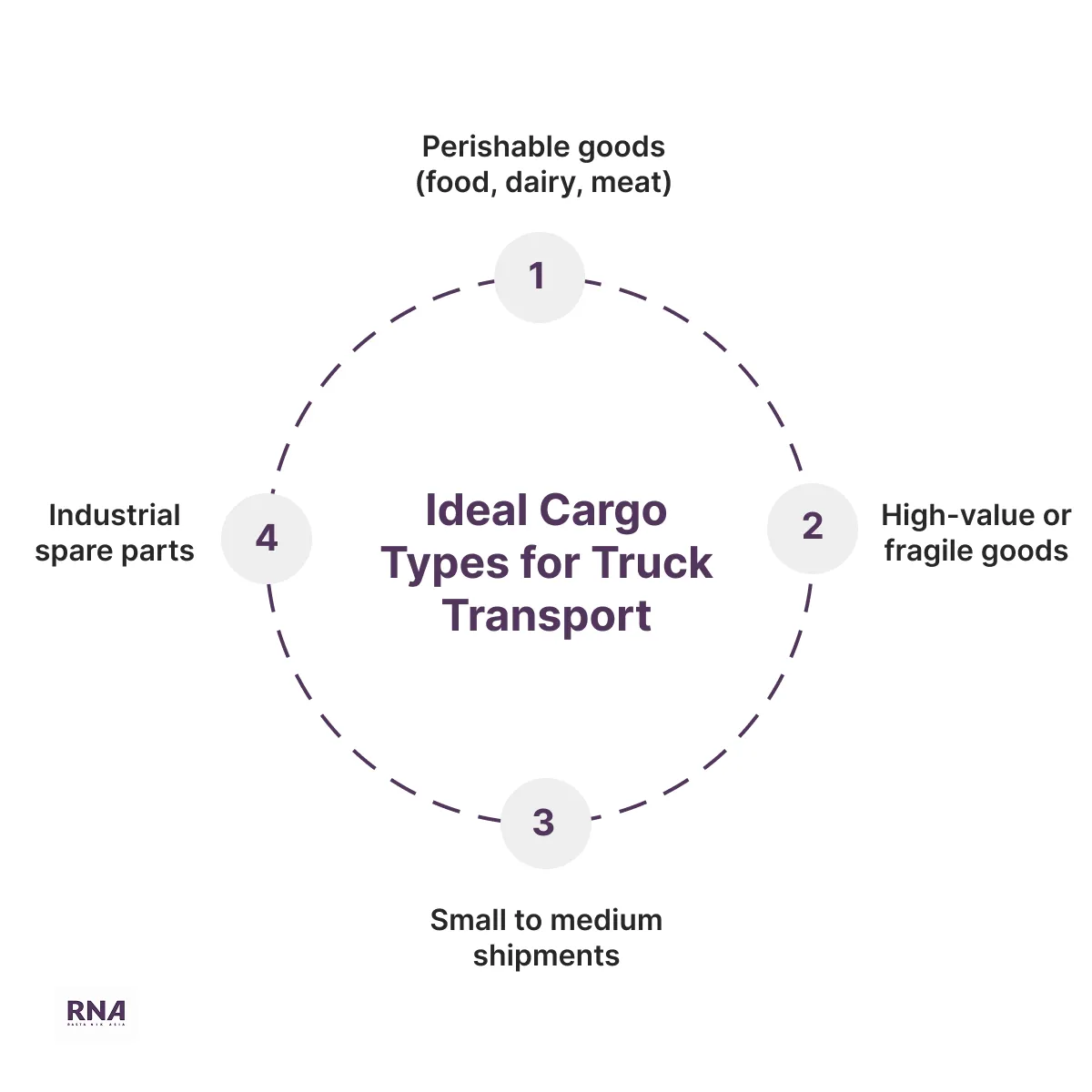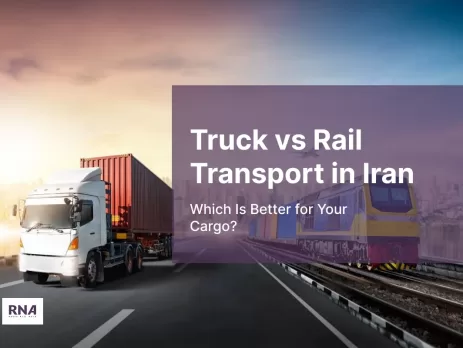When it comes to land transport in Iran, two main options dominate the logistics landscape: truck transport and rail transport. Each plays an essential role in connecting Iranian ports, industrial zones, and border crossings with global markets, especially for traders from CIS countries, India, China, Turkey, and the UAE.
But which option is better for your cargo? Should you move your goods by truck for flexibility and speed, or by rail for large-volume shipments and cost efficiency?
In this guide, we’ll compare truck vs rail transport in Iran, discuss their pros and cons, and help you choose the best option for your trade operations.
Understanding Land Transport in Iran
Land transport in Iran is essential for the country’s import and export logistics. Its strategic location connects the Persian Gulf to Central Asia and Europe, making Iran a key transit corridor in the region.
Two major modes of land transportation serve this network:
- Trucking (road freight): using a wide network of highways connecting ports, cities, and borders.
- Rail freight: covering thousands of kilometers of railway linking southern ports to northern and western borders.
Rasta Nik Asia specializes in both modes, providing multimodal freight services that combine road and rail to move cargo efficiently across Iran.
Truck Transport in Iran: Flexibility and Speed
1. Coverage and Accessibility of truck vs rail transport in Iran
Truck transport covers almost every region in Iran. Highways connect Bandar Abbas, Bushehr, and Imam Khomeini Port to inland cities like Mashhad, Tehran, and Tabriz. They also connect to land borders such as Dogharoon, Bazargan, and Sarakhs.
When comparing truck vs rail transport in Iran, truck transport ideal for businesses that need:
- Door-to-door delivery
- Quick transit from ports to warehouses or border points
- Flexible scheduling
2. Transit Time and Flexibility
When comparing truck vs rail transport in Iran, trucks often win in terms of speed and scheduling flexibility. Trucks can move anytime, adapt routes, and reach destinations that rail cannot.
For example, perishable goods like fruits, vegetables, or frozen meat from Bandar Abbas can reach Central Asia much faster by truck than by train.
3. Cost Considerations in truck vs rail transport in Iran
Truck transport is slightly more expensive per ton-kilometer than rail, especially for long distances. However, the faster transit and lower handling costs can make it more economical for smaller or time-sensitive shipments.
4. Ideal Cargo Types for Truck Transport
- Perishable goods (food, dairy, meat)
- Industrial spare parts
- High-value or fragile goods
- Small to medium shipments
Rail Transport in Iran: Reliable and Cost-Efficient
1. Wide Rail Network
Iran’s railway system connects major ports and borders, forming a key part of land transport in Iran. Main routes link:
- Bandar Abbas to Tehran, Mashhad, and Turkmenistan
- Imam Khomeini Port to Azerbaijan and Turkey
- Sarakhs border to Central Asia
This makes rail transport especially suitable for bulk cargo or transit shipments between the Persian Gulf and CIS countries.
2. Cost Efficiency
When comparing truck vs rail transport in Iran, rail offers significant savings for large-volume shipments over long distances. Rail lowers fuel use, cuts labor costs, and offers consistent rates even when fuel prices change.
3. Safety and Environmental Impact
Rail is safer for long-distance cargo. It has lower accident risks and reduces emissions, helping green logistics efforts. This makes it a good choice for traders who care about the environment.
4. Limitations of Rail vs Truck Transport
Despite its strengths, rail transport has its own challenges like:
- Limited access to final destinations (you still need trucks for last-mile delivery)
- Fixed schedules that may not fit urgent shipments
- Potential delays at loading terminals
Truck vs Rail Transport in Iran: Side-by-Side Comparison
Choosing between truck vs rail transport in Iran often depends on several factors like cost, delivery time, cargo size, and destination access. The table below gives a quick overview to help you compare both options and identify which mode better fits your logistics needs.
| Factor | Truck Transport | Rail Transport |
| Speed | Faster for short and medium distances | Slower but steady for long hauls |
| Flexibility | High — door-to-door delivery | Low — fixed routes and schedules |
| Cost (per ton/km) | Higher | Lower |
| Cargo Type | Perishable, fragile, urgent | Bulk, non-perishable, heavy |
| Coverage | National — reaches all cities and borders | Limited to major terminals |
| Eco-Friendliness | Moderate | High |
| Best For | Small to medium shipments | Bulk or transit cargo |
In short:
- truck transport offers more flexibility and faster movement.
- Rail transport, on the other hand, provides better cost efficiency for large or long-distance shipments.
Many traders find the best solution by combining both modes through multimodal land transport in Iran. This approach ensures a balance between speed and savings.
Truck vs Rail Transport in Iran, Which One Should You Choose?
Choosing between truck vs rail transport in Iran depends on your priorities:
- If you need speed and flexibility: Choose truck transport for urgent or perishable goods.
- If you ship in bulk or need cost efficiency: Choose rail transport for heavy, non-perishable cargo.
- If you want both: Rasta Nik Asia offers multimodal solutions, combining road and rail to achieve optimal cost, speed, and reliability.
For instance, your cargo can move from Bandar Abbas by rail to Mashhad. It can then continue by truck to Turkmenistan or Afghanistan, reducing costs while keeping delivery control.
Contact Rasta Nik Asia today to discuss your shipment needs and get a customized land transport in Iran plan that perfectly fits your timeline, budget, and cargo type.
How Rasta Nik Asia Optimizes Land Transport in Iran
As a leading FIATA-licensed logistics company, Rasta Nik Asia provides end-to-end support for land transport in Iran, ensuring:
- Fast customs clearance at all major borders
- Real-time tracking and transparent reporting
- Reliable partnerships with local carriers and rail authorities
- 24/7 communication with multilingual support
Our regional offices and representatives at Iran’s key borders, from Dogharoon to Bazargan, ensure smoother transit and faster delivery for international traders.
Practical Tips for Choosing between Truck vs Rail Transport in Iran
- Evaluate cargo size and type: small or time-sensitive shipments fit better with trucks.
- Consider destination access: if your final delivery point isn’t near a rail terminal, add trucking for last-mile delivery.
- Balance cost and speed: sometimes a combination of both modes offers the best results.
- Work with a logistics expert: companies like Rasta Nik Asia can assess your route and cargo type to build the most efficient solution.
Conclusion
Both truck and rail transport in Iran have their strengths. The best choice between truck vs rail transport in Iran depends on your cargo’s nature, timeline, and budget. By working with an experienced logistics partner like Rasta Nik Asia, you don’t have to choose one over the other, you can combine both for the most efficient land transport in Iran.
Whether you need fast trucking to CIS countries or cost-effective rail transport across Iran, Rasta Nik ensures your cargo moves safely, on time, and with full visibility.
Contact Rasta Nik Asia today to discuss your next shipment and discover the most effective transport solution for your trade.

